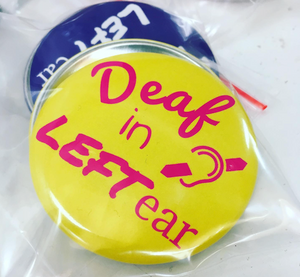Why Wearing Disability Badges Helps Those With Special Needs
Posted by MakeBadges on 13th Feb 2024
If you’re in a place where inclusivity and understanding are paramount, disability badges are a subtle yet powerful tool for individuals of any age with special needs. These badges serve as a non-verbal communicator, a bridge that conveys their needs and challenges to the surrounding community without the needy for verbal explanation.
For many with disabilities, the mere act of having to repeatedly articulate their condition to strangers can be exhausting, sometimes leading to uncomfortable or misunderstood interactions.
Disability badges, however, offer the next best alternative. They carry clear symbols or messages that instantly inform others of the wearer's specific needs, whether it's a seating priority, extra time, or a need for a calmer environment. This silent signal fosters an atmosphere of understanding and empathy, allowing those with special needs to navigate social and public spaces more comfortably.
What Are Disability Badges?
Disability badges are customised badges, often in the form of pins, stickers, or cards, designed to signify that an individual has a disability. These badges serve a crucial function by subtly communicating the person's specific needs or challenges to others in their surroundings.
The concept of disabled badges is rooted in the idea of promoting greater understanding and inclusivity for individuals with disabilities in everyday situations. These badges feature clear symbols or text that denote a specific type of disability, be it physical, neurological, or otherwise. For example, badges may indicate that a person has a hearing impairment, autism, or a condition that requires them to sit down frequently.
The use of disability badges is a response to several challenges faced by individuals with disabilities.
It reduces the need for verbal disclosure, which can be emotionally taxing or impractical in some situations. It also assists others in recognising and respecting the needs of someone with a disability, leading to more empathetic and considerate interactions. In public spaces, these badges can be particularly useful, for instance, in helping others understand why someone might need priority seating or additional assistance.
Types of Disability Badges
Disability badges come in various types, each designed to address specific needs or conditions. These badges not only raise awareness but also assist in creating a more inclusive and understanding environment for individuals with disabilities. Here are some common types of disability badges:
Special Needs Badges
These badges are designed for individuals with a range of special needs, including developmental disorders like ASD or ADHD. They help others understand that the person may interact or respond differently in social situations.
Service Dog Badges
Worn by service animals, these badges indicate that the dog is more than a pet and is essential for the well-being of their handler. They often state phrases like "Service Dog" or "Do Not Pet" to inform others of their role and the need for uninterrupted service to help an individual with a disability
Hearing Impairment Badges
These badges signify to people that the wearer has a hearing disability. They alert others to the need for clear visual communication, patience, or the use of alternative communication methods.
Mobility Impairment Badges
Used by individuals with mobility issues, these badges can indicate a range of conditions from difficulty standing for long periods to the necessity of a wheelchair or other mobility aids.
Invisible Disability Badges
These are for disabilities that are not immediately apparent, such as chronic pain, mental health conditions, or respiratory disorders. They help in gaining understanding or assistance as needed without the person having to explain their condition.
Priority Seating Badges
Often used in public transport, these badges indicate that the person needs to sit down due to a disability, which might not be immediately obvious to others.
Medical Alert Badges
These badges indicate that the person has a medical condition that might require immediate attention, such as diabetes, epilepsy, or severe allergies.
Communication Difficulty Badges
For individuals who have difficulty in verbal communication, possibly due to conditions like aphasia, cerebral palsy, or autism. These badges let others know that patience and alternative communication methods might be needed.
How Are Disability Badges Used?
Disability badges are often designed to be easily attached to any type of clothing. They can come in the form of conveniently sized buttons or pins, which can be quickly pinned to a shirt, jacket, or bag. This flexibility allows the wearer to choose the most visible and convenient spot to place their badge, depending on their outfit and the setting.
Besides buttons, disability badges can also be made as flat laminated plastic tags. These can be attached using a lanyard, clip, or magnets, providing alternative options for individuals who might find pins difficult to handle or for situations where a pin is not suitable.
To learn more about disability badge orders in Australia, feel free to get in touch with our team at Make Badges. We offer durable and nominally priced badges with quick delivery. Place your order with us today.


